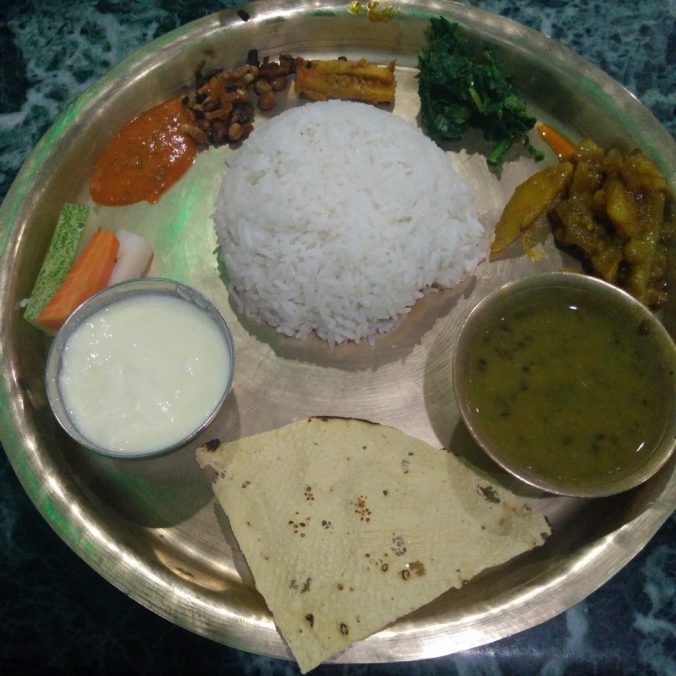It was my maiden visit to Kathmandu, Nepal.
My country India and Nepal share a common history, ancestry, culture and religion with each other,
ties that can be traced back to many millennia.
So, I wasn’t much surprised when I found as much a sense of familiarity as a deep sense of novelty with Nepal at first glance. The people dressed the same as Indians did, the vehicles on the road were the same as back home and so was the nonchalant acceptance of chaos on the streets.
Even the shops had much of their stock imported from India.
Much to my surprise, I could even use Indian currency to shop in Nepal.
In many senses, Nepal felt like a younger brother to India.
To me, the most lasting cultural experience in a new country is the culinary delights it has to offer. Walking unsuspectingly along a backpackers’ ghetto, I looked around for signs of authentic Nepali cuisine.
I spotted a restaurant where locals were having their afternoon meal. Its warm and inviting energy beckoned me in.
The first dish on the menu was Nepali Khana Set Thali. Without another thought, I placed an order for one.
Within minutes, I had Thali (Plate) on my table.
The Thali was made of a copper alloy, with a couple of small bowls arranged on the side.
The contents looked quite similar to a Thali back in India.
A dollop of steaming hot rice, a bowlful of Dal (Lentil soup), a curry of potatoes and peas, a green spinach stir fry, a dried leafy fermented vegetable preparation, three different pickles and a token salad of one slice each of carrot, radish and cucumber.
By the looks of it, I was expecting a much similar taste as that of a regular Indian meal.
But boy was I wrong !
Each subsequent bite only took me by delightful surprise.
The rice was pearly and mildly sticky, cooked to perfection, tasty even just by itself. The dal was a perfect masquerade, looking every bit like the India dal but having a teasingly peculiar flavor, spiced delicately but by no means spicy.
The potatoes and peas, blended easily with whatever else you chose to eat it with.
The greens were cooked just right, minimally, with the right amount of water retained to keep it succulent. It was the perfect example of how to cook greens, right to the sweet spot.
I was particularly surprised by the fermented mustard leaf preparation called ‘Gundruk’, a flavor reminiscent of Punjabi Sarson da saag but tasting nothing like it.
Then, came the deal breaker trio of pickles. A spiced radish slice fermented just right and nuggets of soybean peppered with chilli and coriander.
As surprisingly flavorful as they were, the icing on the cake was the red achaar on the Thali.
At first I could not even tell what it was made of. Each time I tasted it, it whispered one of the ingredients to my tantalised toungue.
With a base of Nepali tomatoes, it had undertones of local chilli (khursani) , coriander , salt and the soul of Nepal in some way. It had a tangy yet citrus aftertaste, a heavenly blend of ingredients.
Each morsel of the meal had such personality, it felt as if I was having an intimate meeting Nepal with each bite.
Ofcourse, I asked for second portions of each dish and ate as avidly as the first time.
Satiated with this surprise of an experience, with a loosened belt, I sat back wondering..
It is likely that many of the ingredients in this Thaali were imported from India. Yet, each and every dish, can stand on its own,
working together to create an experience even better than the sum of its parts.
In a way, my preconceived notion about Nepal was proven to be wrong within the first few hours.
It was quite akin to the experience of brotherhood.
An elder brother undoubtedly has a deep influence on his younger sibling. And sometimes it is taken for granted by the elder one how his younger brother would imitate much of what he does.
Being a younger brother in real life, I have been through this imitation game.
Hence, I could understand why I expected a Nepal Thali (Say younger brother) would be quite similar to the character of the Indian Thali (Elder sibling).
But it is a moment of great pride to realise how a younger brother has its own individual voice, despite the common background and upbringing.
Through this culinary experience, despite being the younger sibling in my family,
I could feel the elation of an elder sibling when he realises that his younger brother has always had such a distinct and pleasing character.
Much of it has also to do with my lack of exposure and awareness about the Nepali cuisine and culture.
But now,
My respect and admiration for Nepali culture has found firm ground in my heart.
I see the Thali in front of me at the moment. I finished everything on the plate but the salad.
Neatly arranged still,
There are three slices of Carrot, Radish and Cucumber,
Shades of orange, white and green,
Reminding me of the Indian flag, feebly hinting at our common culture despite our distinct geopolitical reality.
I smile.
And deep in my heart,
I know I will have many more Nepali Thalis to relish this unique experience,
Of the perfect blend of
familiarity and novelty.

Leave a Reply